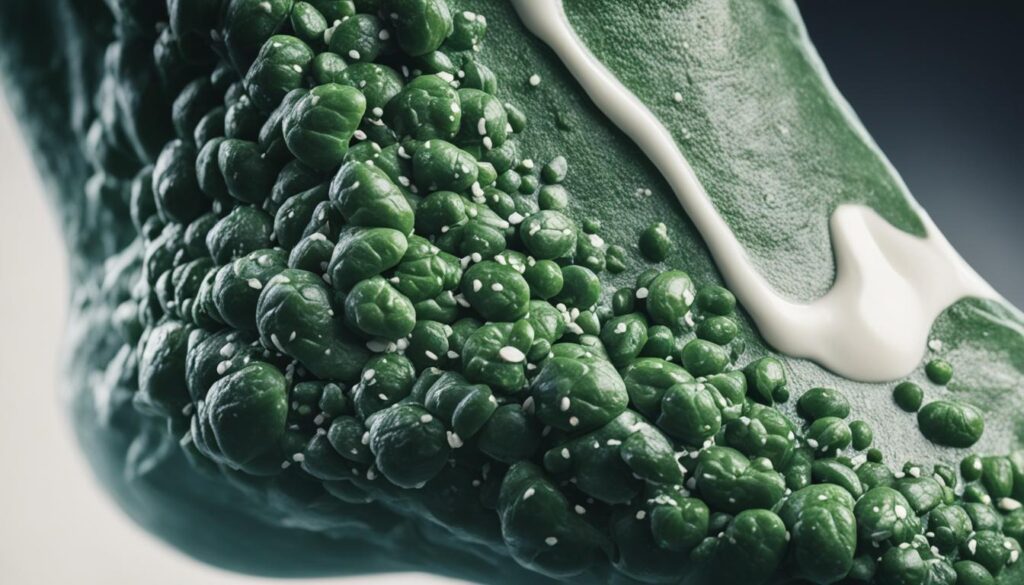As someone who experiences leg cramps, you may be wondering what you can do to prevent them. One effective strategy is to ensure an adequate intake of calcium. Calcium is not only essential for maintaining healthy bones and teeth but also plays a crucial role in preventing leg cramps.
The importance of calcium in preventing leg cramps cannot be overstated. Calcium is involved in muscle contraction and the transmission of signals to the nerves. When calcium levels are insufficient, it can lead to weakened bones and an increased risk of fractures. Muscle cramps, especially in the back and legs, can be a common symptom of calcium deficiency.
To prevent leg cramps and promote overall muscle health, it’s important to aim for the recommended daily intake of calcium. According to the Institute of Medicine, adults should consume 1,000 milligrams of calcium per day. Pregnant or breastfeeding individuals may require a higher intake, around 1,200 to 1,300 milligrams.
There are various dietary sources of calcium that you can incorporate into your meals and snacks. Milk and dairy products, such as Parmesan cheese and plain yogurt, are excellent sources. Additionally, calcium supplements can be beneficial, especially for those who struggle to meet their daily calcium needs through food alone.
Key Takeaways:
- Calcium plays a crucial role in preventing leg cramps.
- Insufficient calcium levels can lead to weakened bones and an increased risk of fractures.
- Muscle cramps, especially in the back and legs, can be a common symptom of calcium deficiency.
- Adults should aim to consume 1,000 milligrams of calcium per day.
- Dietary sources of calcium include milk, dairy products, and Parmesan cheese.
The Symptoms of Calcium Deficiency
If you have low calcium levels for an extended period, you may experience various symptoms. These symptoms can serve as crucial indicators of a deficiency and should not be ignored. The most common symptom of calcium deficiency is frequent muscle cramps, particularly in the back and legs. These cramps can be debilitating and may significantly impact daily activities.
In addition to muscle cramps, there are other signs that may suggest a lack of calcium in the body. One such sign is brittle fingernails. Calcium plays a vital role in maintaining healthy nails, and a deficiency can lead to weak and easily breakable nails.
Inadequate calcium levels also increase the risk of bone-related injuries. Without sufficient calcium, bones can become weak and prone to fractures. This is especially prevalent in older individuals who may already be at a higher risk for osteoporosis.
Another symptom of calcium deficiency is an irregular heartbeat. Calcium is essential for proper heart functioning, and insufficient levels can disrupt the regular rhythm of the heart.
Additionally, individuals with low calcium may experience a tingling sensation in their arms and legs. This tingling, medically known as paresthesia, can be uncomfortable and may indicate a deficiency that needs to be addressed.
It’s crucial to recognize these symptoms and consult with a healthcare professional if you experience any of them. Calcium deficiencies can have severe consequences if left untreated, and addressing them promptly is vital for overall health and well-being.
Symptoms of Calcium Deficiency
| Symptoms | Explanation |
|---|---|
| Frequent Muscle Cramps | Especially in the back and legs |
| Brittle Fingernails | Weak and easily breakable nails |
| Bone-related Injuries | Increased risk of fractures |
| Irregular Heartbeat | Disruption in heart rhythm |
| Tingling in Arms and Legs | Uncomfortable sensations known as paresthesia |
The Link Between Calcium and Muscle Cramps
Calcium plays a vital role in muscle contraction. Low levels of calcium can lead to an increased frequency of muscle cramps. When calcium is not present in sufficient amounts, it can hinder the interaction between actin and myosin, two proteins involved in muscle contraction.

Calcium triggers the movement of regulatory proteins that ultimately allow actin and myosin to interact properly, leading to smooth muscle contractions.
Ensuring an adequate intake of calcium can help reduce the occurrence of muscle cramps.
| Role of Calcium in Reducing Leg Cramps | How Calcium Helps Prevent Leg Cramps |
|---|---|
| Facilitates proper interaction between actin and myosin proteins | Triggers movement of regulatory proteins |
| Promotes smooth muscle contractions | Reduces the frequency of muscle cramps |
| Ensures muscle contraction efficiency | Maintains optimal muscle function |
By incorporating calcium-rich foods into your diet and potentially considering calcium supplements, you can support your body in preventing leg cramps and promoting overall muscle health.
Dietary Sources of Calcium
To meet your daily calcium needs, it’s important to include calcium-rich foods in your diet. Milk and dairy products are excellent sources of calcium. A cup of milk contains around 305 milligrams of calcium, while an ounce of Parmesan cheese provides approximately 331 milligrams. Plain, full-fat yogurt is another good option, with 8 ounces containing about 274 milligrams of calcium. By incorporating these foods into your meals and snacks, you can ensure you’re getting an adequate amount of calcium.
| Food Source | Calcium Content (per serving) |
|---|---|
| Milk | Approximately 305 milligrams (per cup) |
| Parmesan Cheese | Approximately 331 milligrams (per ounce) |
| Plain Yogurt | Approximately 274 milligrams (per 8 ounces) |
Include these calcium-rich foods in your diet to ensure optimal intake.
The Role of Calcium Supplements
In addition to dietary sources, calcium supplements can be beneficial for individuals who struggle to meet their daily calcium needs through food alone. Calcium supplements come in various forms, including tablets, chewables, and liquids. They provide an additional source of calcium to help prevent deficiencies and reduce the risk of muscle cramps.
Calcium supplements offer several benefits for preventing leg cramps:
- Increased Calcium Intake: Calcium supplements offer a convenient way to augment your daily calcium intake and ensure you meet the recommended requirements.
- Reduced Risk of Calcium Deficiency: By providing a supplemental source of calcium, these supplements help prevent deficiencies that can lead to leg cramps and other symptoms associated with low calcium levels.
- Support for Muscle Function: Calcium plays a vital role in muscle contraction. Adequate calcium intake can help keep your muscles functioning optimally, reducing the frequency and severity of leg cramps.
However, it’s essential to consult with a healthcare professional before starting any calcium supplements. They can evaluate your specific needs and guide you in determining the appropriate dosage and type of supplement to address your calcium requirements effectively.
| Calcium Supplement Type | Calcium Content |
|---|---|
| Tablets | Varies depending on the brand and formulation |
| Chewables | Approximately 500-600 milligrams per serving |
| Liquids | Varies depending on the brand and concentration |

Expert Quote:
“Calcium supplements can serve as a valuable addition to a person’s dietary intake, especially for those who have difficulty meeting their calcium needs through food alone. They provide an extra source of calcium to support bone health and prevent leg cramps.”
To maximize the effectiveness of calcium supplements, it’s crucial to combine them with a balanced diet that includes calcium-rich foods. This approach ensures a comprehensive intake of essential nutrients for optimal bone and muscle health.
Other Strategies to Prevent Leg Cramps
In addition to ensuring adequate calcium intake, there are other strategies you can incorporate to prevent leg cramps. Taking proactive steps to keep your muscles healthy and hydrated is essential for minimizing the occurrence of cramps.
Regular Stretching
One effective strategy for preventing leg cramps is to incorporate regular stretching exercises into your routine. Stretching helps improve muscle flexibility and reduces the likelihood of cramps. Focus on stretching the specific muscle groups that are prone to cramping, such as the calves and hamstrings. You can try simple stretches like the calf stretch or the standing hamstring stretch. Make sure to hold each stretch for at least 30 seconds and repeat on both sides. Incorporating stretching into your warm-up and cool-down routine can also be beneficial.
Hydration
Staying hydrated is vital for preventing muscle cramps, including leg cramps. Dehydration can contribute to the onset of cramps, as it can lead to an electrolyte imbalance and impair muscle function. Make sure to drink enough water throughout the day, especially before, during, and after physical activity. The exact amount of water you need may vary depending on factors such as your body weight, activity level, and climate. A general guideline is to aim for at least 8 cups (64 ounces) of water per day. If you engage in intense physical activity or exercise in hot weather, you may need to increase your water intake.
Electrolyte Balance
Maintaining a balanced electrolyte level is crucial for muscle function and preventing leg cramps. Electrolytes are minerals that play a role in conducting electrical impulses in the body and regulating muscle contractions. Key electrolytes involved in muscle health include calcium, potassium, and magnesium. To maintain an adequate electrolyte balance, incorporate foods rich in these minerals into your diet. Bananas, leafy greens, nuts, and seeds are excellent sources of potassium and magnesium. Dairy products, such as milk and yogurt, along with fortified cereals, are good sources of calcium. A balanced diet that includes a variety of nutrient-rich foods can help ensure you’re getting the electrolytes your muscles need.
To summarize, preventing leg cramps involves more than just calcium intake. By incorporating regular stretching exercises, staying hydrated, and maintaining a balanced electrolyte level, you can effectively reduce the likelihood of experiencing leg cramps. These strategies work together to keep your muscles healthy, flexible, and functioning optimally.
Conclusion
In conclusion, calcium is vital for preventing leg cramps as it ensures proper muscle contraction and reduces the risk of deficiencies. By maintaining adequate calcium intake, we can not only support healthy bones, heart, and nervous systems but also prevent the occurrence of muscle cramps. Incorporating calcium-rich foods into our diet, such as milk, dairy products, and plain yogurt, can help us meet our daily calcium needs.
In cases where it’s challenging to obtain enough calcium from food alone, calcium supplements can be beneficial. They provide an additional source of calcium, reducing the risk of deficiencies and muscle cramps. However, it’s crucial to seek guidance from a healthcare professional to determine the appropriate dosage for individual needs.
Furthermore, implementing strategies like regular stretching exercises, proper hydration, and maintaining a balanced electrolyte intake can enhance muscle health and minimize the occurrence of leg cramps. Stretching improves muscle flexibility, while staying hydrated and ensuring a balanced electrolyte level, including calcium, potassium, and magnesium, optimizes muscle function.
Remember, consulting with a healthcare professional is essential to receive personalized advice and recommendations tailored to individual circumstances. By prioritizing calcium intake and adopting effective preventive measures, we can take proactive steps towards reducing leg cramps and promoting overall muscle health.
FAQ
What role does calcium play in preventing leg cramps?
Calcium plays a vital role in preventing leg cramps by ensuring proper muscle contraction and reducing the risk of deficiencies.
What are the symptoms of calcium deficiency?
Symptoms of calcium deficiency include frequent muscle cramps, brittle fingernails, bone-related injuries, irregular heartbeat, and tingling in the arms and legs.
How does calcium help prevent leg cramps?
Calcium is crucial for muscle contraction. Adequate calcium levels ensure smooth muscle contractions and reduce the frequency of leg cramps.
What are some dietary sources of calcium?
Milk, dairy products, Parmesan cheese, and plain yogurt are excellent sources of calcium.
How can calcium supplements help prevent leg cramps?
Calcium supplements can provide additional calcium to help prevent deficiencies and reduce the risk of muscle cramps. However, it’s essential to consult with a healthcare professional before starting any supplements.
What are other strategies to prevent leg cramps?
Regular stretching exercises, staying hydrated, and maintaining a balanced electrolyte level by consuming foods rich in electrolytes can help prevent leg cramps.
How does calcium play a role in preventing leg cramps?
Adequate calcium intake ensures proper muscle contraction and reduces the risk of calcium deficiencies, which can lead to increased leg cramps.





